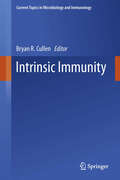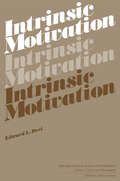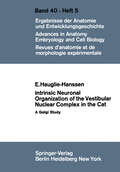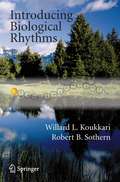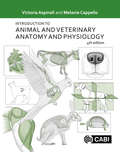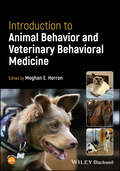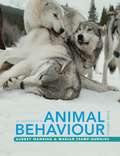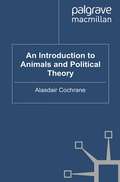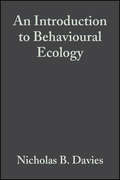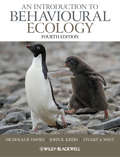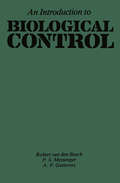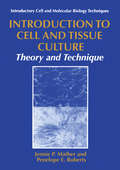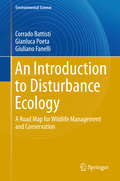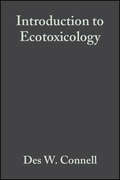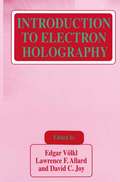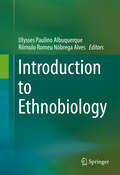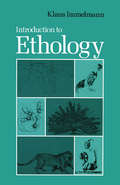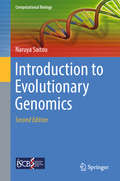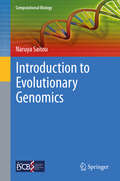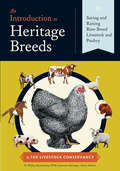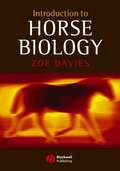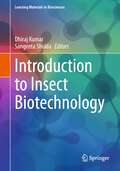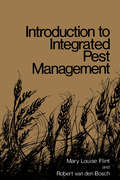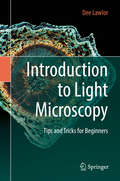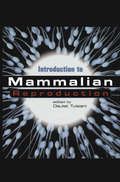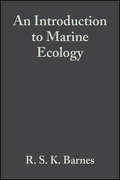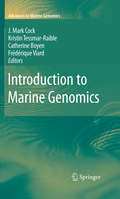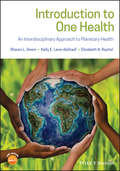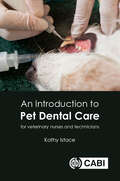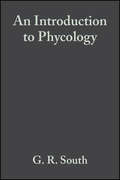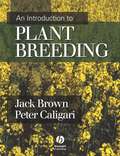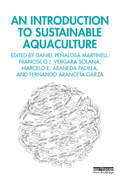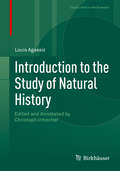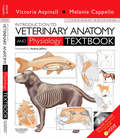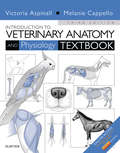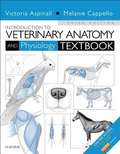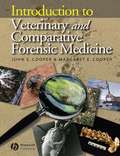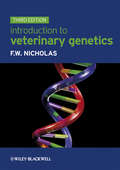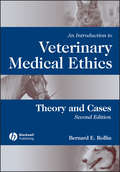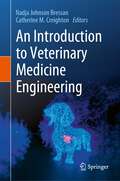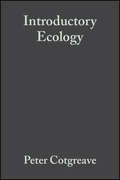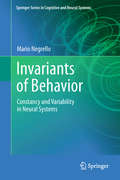- Table View
- List View
Intrinsic Immunity (Current Topics in Microbiology and Immunology #371)
by Bryan R. CullenRecent research has focused attention on the importance of intrinsic antiviral immunity, i.e. immunity mediated by factors that are constitutively expressed in many cells. In this volume, leading experts provide a comprehensive overview of this relatively new and rapidly evolving field. They cover intrinsic proteinaceous antiviral immune effectors, such as the APOBEC3 and TRIM protein families as well as Tetherin and SAMHD1, which were initially discovered by researchers studying HIV-1. Furthermore, the role of RNA interference in antiviral defense in plants and invertebrates, as well as the interplay between microRNAs and viruses in mammalian cells, are analysed. One chapter discusses how intrinsic immunity and viral countermeasures to intrinsic immune effectors drive both pathogen and host evolution, and finally the emerging evidence that DNA damage response proteins restrict infection by DNA viruses is highlighted.
Intrinsic Motivation (Perspectives in Social Psychology)
by Edward L. DeciAs I begin to write this Preface, I feel a rush of excitement. I have now finished the book; my gestalt is coming into completion. Throughout the months that I have been writing this, I have, indeed, been intrinsically motivated. Now that it is finished I feel quite competent and self-determining (see Chapter 2). Whether or not those who read the book will perceive me that way is also a concern of mine (an extrinsic one), but it is a wholly separate issue from the intrinsic rewards I have been experiencing. This book presents a theoretical perspective. It reviews an enormous amount of research which establishes unequivocally that intrinsic motivation exists. Also considered herein are various approaches to the conceptualizing of intrinsic motivation. The book concentrates on the approach which has developed out of the work of Robert White (1959), namely, that intrinsically motivated behaviors are ones which a person engages in so that he may feel competent and self-determining in relation to his environment. The book then considers the development of intrinsic motiva tion, how behaviors are motivated intrinsically, how they relate to and how intrinsic motivation is extrinsically motivated behaviors, affected by extrinsic rewards and controls. It also considers how changes in intrinsic motivation relate to changes in attitudes, how people attribute motivation to each other, how the attribution process is motivated, and how the process of perceiving motivation (and other internal states) in oneself relates to perceiving them in others.
Intrinsic Neuronal Organization of the Vestibular Nuclear Complex in the Cat: A Golgi Study (Advances in Anatomy, Embryology and Cell Biology #40/5)
by E. Hauglie-HanssenIntroducing Biological Rhythms: A Primer on the Temporal Organization of Life, with Implications for Health, Society, Reproduction, and the Natural Environment
by Willard L. Koukkari Robert B. SothernIntroducing Biological Rhythms is a primer that serves to introduce individuals to the area of biological rhythms. It describes the major characteristics and discusses the implications and applications of these rhythms, while citing scientific results and references. Also, the primer includes essays that provide in-depth historic and other background information for those interested in more specific topics or concepts. It covers a basic cross-section of the field of chronobiology clearly enough so that it can be understood by a novice, or an undergraduate student, but that it would also be sufficiently technical and detailed for the scientist.
Introduction to Animal and Veterinary Anatomy and Physiology
by Victoria Aspinall BVSc, MRCVS Melanie Cappello BSc (Hons) ZooloA sound knowledge of anatomy and physiology is an essential basis for the effective clinical treatment of companion animals and farm animals alike. The fourth edition of this bestselling book continues to provide a comprehensive description of the anatomy and physiology of dogs and cats. The book builds on these foundations with detailed descriptions of exotic small species including birds, and domestic farm animals, including cows, sheep and pigs, as well as the horse. The text: Contains detailed descriptions of the systematic anatomy and physiology of a wide range of animal species. Covers clinical conditions and disease examples related to the individual body systems. Includes applied anatomy tips that relate theory to clinical practice. Is written by expert authors with a wealth of veterinary, animal science and teaching experience. Includes more clinical application examples and question and answer tests to reinforce student learning. Has been updated with more information for animal science students. This text provides an essential basis for all those embarking upon a veterinary, animal science or animal management career.
Introduction to Animal Behavior and Veterinary Behavioral Medicine
by Meghan E. HerronIntroduction to Animal Behavior and Veterinary Behavioral Medicine Understand and apply key concepts of animal behavior in veterinary practice Animal behavior is a critical aspect of veterinary medicine, often underappreciated despite its pervasiveness throughout the field. Understanding animal behavior can facilitate communication with patients, refine diagnoses and indications of ill health, and aid in processes of learning and socialization. Introduction to Animal Behavior and Veterinary Behavioral Medicine offers a comprehensive overview of the key concepts underlying the behavior of multiple animal species before demonstrating how to apply these concepts clinically. The result is an indispensable resource for veterinary students and practitioners who want to deepen their understanding of patient needs. Introduction to Animal Behavior and Veterinary Behavioral Medicine readers will also find: Comprehensive coverage of companion animal behavior and additional coverage of livestock and wild animal behavior Detailed discussion of topics including social development, animal learning, and applied behavior analysis In depth review of diagnosis and treatment strategies for common behavior disorders in companion animals, extending to various additional species Companion website with videos, handouts for downloading, and links to pertinent scientific articles and informative websites Introduction to Animal Behavior and Veterinary Behavioral Medicine is ideal preparation for veterinary medical students as part of “day one readiness” in their professional careers, as well as veterinary practitioners looking for a solid foundation in animal behavior and the treatment of key issues.
Introduction to Animal Behavior and Veterinary Behavioral Medicine
by Meghan E. HerronIntroduction to Animal Behavior and Veterinary Behavioral Medicine Understand and apply key concepts of animal behavior in veterinary practice Animal behavior is a critical aspect of veterinary medicine, often underappreciated despite its pervasiveness throughout the field. Understanding animal behavior can facilitate communication with patients, refine diagnoses and indications of ill health, and aid in processes of learning and socialization. Introduction to Animal Behavior and Veterinary Behavioral Medicine offers a comprehensive overview of the key concepts underlying the behavior of multiple animal species before demonstrating how to apply these concepts clinically. The result is an indispensable resource for veterinary students and practitioners who want to deepen their understanding of patient needs. Introduction to Animal Behavior and Veterinary Behavioral Medicine readers will also find: Comprehensive coverage of companion animal behavior and additional coverage of livestock and wild animal behavior Detailed discussion of topics including social development, animal learning, and applied behavior analysis In depth review of diagnosis and treatment strategies for common behavior disorders in companion animals, extending to various additional species Companion website with videos, handouts for downloading, and links to pertinent scientific articles and informative websites Introduction to Animal Behavior and Veterinary Behavioral Medicine is ideal preparation for veterinary medical students as part of “day one readiness” in their professional careers, as well as veterinary practitioners looking for a solid foundation in animal behavior and the treatment of key issues.
An Introduction To Animal Behaviour (400MB+ File Request)
by Aubrey Manning Marian Stamp Dawkins400MB+ File Request. Wolves excitedly greet each other as members of the pack come together; a bumble bee uses its long tongue to reach the nectar at the base of a foxglove flower; a mongoose swiftly and deftly bites its prey to death; young cheetahs rest quietly together, very close to sleep. Now in full colour, this revised and updated edition of Manning and Dawkins' classic text provides a beautifully written introduction to the fundamentals of animal behaviour. Tinbergen's four questions of causation, evolution, development and function form the fundamental framework of the text, illustrated with fascinating examples of complex behavioural mechanisms. The authors provide accounts of all levels of behaviour from the nerve cell to that of the population. The strengths of An Introduction to Animal Behaviour as a textbook include its clear explanations and concise, readable text and the enthusiasm of the authors for their subject.
An Introduction To Animals And Political Theory (The\palgrave Macmillan Animal Ethics Ser. )
by Alasdair CochraneStructured around the five most important schools within contemporary political theory: liberalism, utilitarianism, communitarianism, Marxism and feminism, this is the first introductory level text to offer an accessible overview on the status of animals in contemporary political theory.
An Introduction To Animals And Political Theory (The\palgrave Macmillan Animal Ethics Ser. )
by Alasdair CochraneStructured around the five most important schools within contemporary political theory: liberalism, utilitarianism, communitarianism, Marxism and feminism, this is the first introductory level text to offer an accessible overview on the status of animals in contemporary political theory.
An Introduction to Behavioural Ecology
by Nicholas B. Davies John R. KrebsThe third edition of this successful textbook looks again at the influence of natural selection on behavior - an animal's struggle to survive by exploiting resources, avoiding predators, and maximizing reproductive success. In this edition, new examples are introduced throughout, many illustrated with full color photographs. In addition, important new topics are added including the latest techniques of comparative analysis, the theory and application of DNA fingerprinting techniques, extensive new discussion on brood parasite/host coevolution, the latest ideas on sexual selection in relation to disease resistance, and a new section on the intentionality of communication. Written in the lucid style for which these two authors are renowned, the text is enhanced by boxed sections illustrating important concepts and new marginal notes that guide the reader through the text. This book will be essential reading for students taking courses in behavioral ecology. The leading introductory text from the two most prominent workers in the field. Second colour in the text. New section of four colour plates. Boxed sections to ilustrate difficult and important points. New larger format with marginal notes to guide the reader through the text. Selected further reading at the end of each chapter.
An Introduction to Behavioural Ecology
by Nicholas B. Davies John R. Krebs Stuart A. WestThis textbook helped to define the field of Behavioural Ecology. In this fourth edition the text has been completely revised, with new chapters and many new illustrations and full colour photographs. The theme, once again, is the influence of natural selection on behaviour – an animal's struggle to survive and reproduce by exploiting and competing for resources, avoiding predators, selecting mates and caring for offspring, – and how animal societies reflect both cooperation and conflict among individuals. Stuart A. West has joined as a co-author bringing his own perspectives and work on microbial systems into the book. Written in the same engaging and lucid style as the previous editions, the authors explain the latest theoretical ideas using examples from micro-organisms, invertebrates and vertebrates. There are boxed sections for some topics and marginal notes help guide the reader. The book is essential reading for students of behavioural ecology, animal behaviour and evolutionary biology. Key Features: Long-awaited new edition of a field-defining textbook New chapters, illustrations and colour photographs New co-author Focuses on the influence of natural selection on behavior, and how animal societies reflect both cooperation and conflict among individuals “The long-awaited update to a classic in this field is now here, presenting new directions in thinking and addressing burning questions. Richly informed by progress in many other disciplines, such as sensory physiology, genetics and evolutionary theory, it marks the emergence of behavioural ecology as a fully fledged discipline….. This is a marvellous book, written in a lucid style. A must-read for those in the field, it is also a cornucopia of new thinking for anyone interested in evolution and behaviour.” Manfred Milinski, Nature, 2012
An Introduction to Behavioural Ecology
by Nicholas B. Davies John R. Krebs Stuart A. WestThis textbook helped to define the field of Behavioural Ecology. In this fourth edition the text has been completely revised, with new chapters and many new illustrations and full colour photographs. The theme, once again, is the influence of natural selection on behaviour – an animal's struggle to survive and reproduce by exploiting and competing for resources, avoiding predators, selecting mates and caring for offspring, – and how animal societies reflect both cooperation and conflict among individuals. Stuart A. West has joined as a co-author bringing his own perspectives and work on microbial systems into the book. Written in the same engaging and lucid style as the previous editions, the authors explain the latest theoretical ideas using examples from micro-organisms, invertebrates and vertebrates. There are boxed sections for some topics and marginal notes help guide the reader. The book is essential reading for students of behavioural ecology, animal behaviour and evolutionary biology. Key Features: Long-awaited new edition of a field-defining textbook New chapters, illustrations and colour photographs New co-author Focuses on the influence of natural selection on behavior, and how animal societies reflect both cooperation and conflict among individuals “The long-awaited update to a classic in this field is now here, presenting new directions in thinking and addressing burning questions. Richly informed by progress in many other disciplines, such as sensory physiology, genetics and evolutionary theory, it marks the emergence of behavioural ecology as a fully fledged discipline….. This is a marvellous book, written in a lucid style. A must-read for those in the field, it is also a cornucopia of new thinking for anyone interested in evolution and behaviour.” Manfred Milinski, Nature, 2012
An Introduction to Biological Control
by A.P. Gutierrez P.S. Messenger R. van den BoschThis volume is a revision of Biological Control by R. van den Bosch and P. S. Messenger, originally published by Intext Publishers. In the revision, I have attempted to keep the original theme, and to update it with current research findings and new chapters or sections on insect pathology, microbial control of weeds and plant pathogens, population dynamics, integrated pest management, and economics. The book was written as an undergraduate text, and not as a complete review of the subject area. Various more comprehen sive volumes have been written to serve as handbooks for the experts. This book is designed to provide a concise overview of the complex and valuable field of biological control and to show the relationships to the developing concepts of integrated pest management. Population regulation of pests by natural enemies is the major theme of the book, but other biological methods of pest control are also discussed. The chapter on population dynamics assumes a precalculus-level knowledge of mathematics. Author names of species are listed only once in the text, but all are listed in the Appendix. Any errors or omissions in this volume are my sole responsibility. A. P. Gutierrez Professor of Entomology Division of Biological Control University of California, Berkeley vii Acknowledgments Very special thanks must be given to my colleagues, Professors C. B. Huffaker and L. E. Caltagirone, for the very thorough review they provided and for the many positive suggestions they gave. Dr.
Introduction to Cell and Tissue Culture: Theory and Technique (Introductory Cell and Molecular Biology Techniques)
by Jennie P. Mather Penelope E. RobertsIt is a pleasure to contribute the foreword to Introduction to Cell and Tissue Culture: The ory and Techniques by Mather and Roberts. Despite the occasional appearance of thought ful works devoted to elementary or advanced cell culture methodology, a place remains for a comprehensive and definitive volume that can be used to advantage by both the novice and the expert in the field. In this book, Mather and Roberts present the relevant method ology within a conceptual framework of cell biology, genetics, nutrition, endocrinology, and physiology that renders technical cell culture information in a comprehensive, logical for mat. This allows topics to be presented with an emphasis on troubleshooting problems from a basis of understanding the underlying theory. The material is presented in a way that is adaptable to student use in formal courses; it also should be functional when used on a daily basis by professional cell culturists in a- demia and industry. The volume includes references to relevant Internet sites and other use ful sources of information. In addition to the fundamentals, attention is also given to mod ern applications and approaches to cell culture derivation, medium formulation, culture scale-up, and biotechnology, presented by scientists who are pioneers in these areas. With this volume, it should be possible to establish and maintain a cell culture laboratory devot ed to any of the many disciplines to which cell culture methodology is applicable.
An Introduction to Disturbance Ecology: A Road Map for Wildlife Management and Conservation (Environmental Science and Engineering)
by Corrado Battisti Gianluca Poeta Giuliano FanelliThis book represents an introductory review of disturbance ecology and threat analysis, providing schematic concepts and approaches useful for work on sites that are affected by the impact of human actions. It is aimed at conservation and environmental practitioners, who will find tips for choosing methods and approaches when there are conflicts between the natural components and human activity. It is also addressed to students of applied ecology, ecosystem management, land-use planning and environmental impact assessment. It discusses a number of topics covered in the programs of many university courses related to basic ecology and ecology of disturbance, the latter constituting a field of great interest because of its implications and repercussions in applied territorial science. The book is divided into two parts: the first focuses on the theoretical and disciplinary framework of the ecology of disturbance, while the second is devoted to the analysis of anthropogenic threats. This, in particular, discusses the most recent approach, which uses a conventional nomenclature to allow a coarse-grained quantification and objective assessment of threat impact on different environmental components. Such an approach facilitates the comparison of hierarchically different events and, therefore, helps define the priorities for management and conservation strategies.
Introduction to Ecotoxicology
by Des W. Connell Paul Lam Bruce Richardson Rudolf WuEnvironmental pollution is one of the most serious threats to the future health of our planet. A wide and ever increasing range of chemicals from industry, agriculture, medicine and a host of other sources continue to contribute to the earth's chemical load. Governments have encountered great difficulties responding to the crucial and immediate need for effective management. As a result, the new science of ecotoxicology has developed, which provides a broad conceptual framework for evaluating the effects of chemicals in natural ecosystems. This book is aimed principally at undergraduate students who have completed basic courses in both chemistry and biology. It takes a broad view of ecotoxicology starting with the nature, properties and behaviour of environmental toxicants, and extends to dose/response relationships and effects on organisms, populations, communities and ecosystems. Importantly, it also addresses environmental management areas such as biomarkers, biomonitoring, ecological risk assessment and the ecotoxicology and management of chemicals. The book provides an invaluable overview of the subject for students taking courses in ecotoxicology and environmental pollution, as well as wider degree programmes in biology, ecology, wildlife management, environmental science, environmental impact assessment, toxicology, pollution, chemical engineering, civil engineering, sanitation engineering and related subjects.
Introduction to Electron Holography
by Edgar Völkl Lawrence F. Allard David C. JoyExperienced and novice holographers receive a solid foundation in the theory and practice of holography, the next generation of imaging technology, in this superb text. The book's `how to' aspects enable readers to learn hologram acquisition at the microscope and processing of holograms at the computer as well as digital imaging techniques. A complete bibliography on electron holography and applications of the method to problems in materials science, physics and the life sciences round out the volume's coverage.
Introduction to Ethnobiology
by Ulysses Paulino Albuquerque Rômulo Romeu Nóbrega AlvesThis textbook provides a basic introduction to ethnobiology with key concepts for beginners. It is also written for those who teach ethnobiology or related fields. The core issues and concepts, as well as approaches and theoretical positions are fully covered.
Introduction to Ethology
by Klaus ImmelmannEthology, the study of the biology of behavior, has grown tremendously during the last few decades. The large number of accumulated facts is difficult to survey, understanding and an appreciation of the ethological approach to the study of behavior have grown, and the number of attempts at holistic explanations for certain behavioral phenomena has increased. Because of this development it has become more difficult to gain an overview of the field, to keep up with new developments, and to update the subject matter by the inclusion of new facts in the proper place. The nonspecialist is unable to evaluate the more general statements in the popular literature, especially when such works are aimed at a broader audience. Hence, this book has a dual purpose: (1) to lend some order to the dizzying array of information and thus simplify inquiry into ethology; and (2) to present relevant facts and knowledge that will help the reader confronted with numerous studies and articles in the ethological literature.
Introduction to Evolutionary Genomics (Computational Biology #Vol. 17)
by Naruya SaitouThis authoritative textbook/reference presents a comprehensive introduction to the field of evolutionary genomics. The opening chapters describe the fundamental concepts in molecular biology and genome evolution for readers without any prior background in this area. This is followed by a detailed examination of genome evolution in various different groups of organisms. The text then concludes with a review of practical methods essential to researchers in the field.This updated and revised new edition also features historical perspectives on contributions to evolutionary genomics from related fields such as molecular evolution, genetics, and numerical taxonomy.Topics and features: introduces the basics of molecular biology, covering protein structure and diversity, as well as DNA replication, transcription, and translation; examines the phylogenetic relationships of DNA sequences, and the processes of mutation, neutral evolution, and natural selection; presents a brief evolutionary history of life, surveying the key features of the genomes of prokaryotes, eukaryotes, viruses and phages, vertebrates, and humans; reviews the various biological “omic” databases, and discusses the analysis of homologous nucleotide and amino acid sequences; provides an overview of the experimental sequencing of genomes and transcriptomes, and the construction of phylogenetic trees; describes methods for estimating of evolutionary distances, and performing studies of population genetics; supplies additional supporting material at an associated website.Serving as an indispensable textbook for graduate and advanced undergraduate courses on evolutionary genomics, this accessible overview will also prove invaluable to researchers from both computer science and the biological sciences seeking a primer on the field.
Introduction to Evolutionary Genomics (Computational Biology #17)
by Naruya SaitouThis book is the first of its kind to explain the fundamentals of evolutionary genomics. The comprehensive coverage includes concise descriptions of a variety of genome organizations, a thorough discussion of the methods used, and a detailed review of genome sequence processing procedures. The opening chapters also provide the necessary basics for readers unfamiliar with evolutionary studies. Features: introduces the basics of molecular biology, DNA replication, mutation, phylogeny, neutral evolution, and natural selection; presents a brief evolutionary history of life from the primordial seas to the emergence of humans; describes the genomes of prokaryotes, eukaryotes, vertebrates, and humans; reviews methods for genome sequencing, phenotype data collection, homology searches and analysis, and phylogenetic tree and network building; discusses databases of genome sequences and related information, evolutionary distances, and population genomics; provides supplementary material at an associated website.
An Introduction to Heritage Breeds: Saving and Raising Rare-Breed Livestock and Poultry
by D. Phillip Sponenberg DVM Jeannette Beranger Alison MartinThis inviting, visual guide to the world of heritage livestock explains why conserving heritage breeds is important, how to raise the profiled species (including chickens, turkeys, ducks, geese, rabbits, pigs, sheep, goats, cattle, donkeys, and horses), and who are the people working to preserve these breeds.
Introduction to Horse Biology
by Zoe DaviesMany students have only a limited knowledge of biology before starting a variety of equine courses, from BHS stages to National Certificate and Diploma and HND/degree. Introduction to Horse Biology provides all the information students of equine subjects require, particularly those without a GCSE or A level in biology. This book will be invaluable to all students of equine subjects including First Diploma, National Diploma, National Certificate, Higher National Diploma and Higher National Certificate and all students studying for BHS or other equine related examinations. It is also ideal for serious horse owners searching for a better understanding of horses and how they function. The Author Zoe Davies is a former lecturer in equine science, a consultant equine nutritionist, author and external examiner for higher education courses. She has substantial experience in equine management and training. Also from Blackwell Publishing Horse and Stable Management Fourth Edition Jeremy Houghton Brown, Sarah Pilliner and Zoe Davies 1 4051 0007 9 Horse Nutrition and Feeding Second Edition Sarah Pilliner 0 632 05016 0 Teaching Jumping Jane Houghton Brown 0 632 04127 7 Equine Science Second Edition Sarah Pilliner and Zoe Davies 1 4051 1944 6
Introduction to Insect Biotechnology (Learning Materials in Biosciences)
by Dhiraj Kumar Sangeeta ShuklaThis textbook introduces to the fundamentals and applications of insect biotechnology in a concise manner. Global economically important insects such as silkworm, lac or honey bee are in the focus of this text. The book attempts to address all of the latest developments in this growing field such as application of metagenomics and proteomics in mining for genes and enzymes that could be beneficial in diverse industrial and biomedical applications. Further, insects have been established as suitable tool for the production of transgenic products which is discussed in one dedicated chapter. The book targets students and researchers in molecular biology, biotechnology or entomology who want to get familiar with the emerging field of insect biotechnology.
Introduction to Integrated Pest Management
by M.L. Flint R. van den BoschIntegrated control of pests was practiced early in this century, well before anyone thought to call it "integrated control" or, still later, "integrated pest management" (IPM), which is the subject of this book by Mary Louise Flint and the late Robert van den Bosch. USDA entomologists W. D. Hunter and B. R. Coad recommended the same principles in 1923, for example, for the control of boll weevil on cotton in the United States. In that program, selected pest-tolerant varieties of cotton and residue destruction were the primary means of control, with insecticides consid ered supplementary and to be used only when a measured incidence of weevil damage occurred. Likewise, plant pathologists had also developed disease management programs incorporating varietal selection and cul tural procedures, along with minimal use of the early fungicides, such as Bordeaux mixture. These and other methods were practiced well before modern chemical control technology had developed. Use of chemical pesticides expanded greatly in this century, at first slowly and then, following the launching of DDT as a broadly successful insecticide, with rapidly increasing momentum. In 1979, the President's Council on Environmental Quality reported that production of synthetic organic pesticides had increased from less than half a million pounds in 1951 to about 1.4 billion pounds-or about 3000 times as much-in 1977.
Introduction to Light Microscopy: Tips and Tricks for Beginners
by Dee LawlorThis book offers a beginner’s guide to using light microscopes. It begins with a brief introduction to the physics of optics, which will give the reader a basic grasp of the behaviors of light. In turn, each part of the microscope is explained using clear and simple English, together withdetailed photographs and diagrams. The reader will learn the function, care and correct use of each part. A troubleshooting section also helps resolve some of the most common issues encountered in light microscopy. Most people have a general idea of how to use a microscope, but many never get the full benefit, because they receive no training. With easy-to-follow steps and detailed images, this guide will help everyone achieve the best results, and be confident using their microscope. This book is intended for anyone using a light microscope, such as university students, people in lab environments, hobbyists, educators who teach science to young children, and anyone with a general interest in these valuable tools.
Introduction to Mammalian Reproduction
by Daulat TulsianiIntroduction to Mammalian Reproduction is a welcome contribution to the fields of gametogenesis, gamete transport, fertilization, and reproduction technologies. Key topics covered include: *formation and maturation of male gametes; *morphology and physiology of female gametes; *how the sperm meets the egg; *sperm-egg fusion, egg activation, and implantation of fertilized egg; *assisted reproduction and environmental chemicals that have an effect on formation and function of male and female gametes. This book is for both researchers and students involved in reproductive biology.
An Introduction to Marine Ecology
by R. S. Barnes R. N. HughesThis established textbook continues to provide a comprehensive and stimulating introduction to marine ecological concepts and processes. Based on a wealth of international teaching expertise, An Introduction to Marine Ecology is written to be the basis for an entire undergraduate course in marine biology or ecology. It covers the trophic, environmental and competitive interactions of marine organisms, and the effects of these on the productivity, dynamics and structure of marine systems. The strength of the book lies in its discussion of core topics which remains at the heart of the majority of courses in the subject, despite an increasing emphasis on more applied aspects. The authors maintain the tradition of clarity and conciseness set by previous editions, and the text is extensively illustrated with colour plates, photographs and diagrams. Examples are drawn from all over the world. In this edition, the scientific content of the text has been fully revised and updated. An emphasis has been placed on human impacts, and completely new chapters have been added on fisheries, marine ecosystems, and human interference and conservation. Completely revised and updated with a twofold increase in the number of illustrations. Adopts a more applied approach in keeping with current teaching. New chapters on fisheries, the marine ecosystem, conservation and pollution. Based on a proven and successful course structure.
Introduction to Marine Genomics (Advances in Marine Genomics #1)
by J. Mark Cock Kristin Tessmar-Raible Catherine Boyen Frédérique ViardMarine biology has always played an important role in biological research, being at the origin of many key advances. To a certain extent, the influence of marine biology on the biological sciences was overshadowed over a period of several years by the remarkable advances that were made using powerful model organisms from terrestrial environments. This situation is now changing again, however, due primarily to spectacular developments in genomic methodologies that have significantly accelerated research in a broad spectrum of marine biology disciplines ranging from biodiversity to developmental biology to biotechnology. The data generated by marine genomics projects have had an impact on questions as diverse as understanding planetary geochemical cycles, the impact of climate change on marine fauna and flora, the functioning of marine ecosystems, the discovery of new organisms and novel biomolecules, and investigation of the evolution of animal developmental complexity. This book represents the first attempt to document how genomic technologies are revolutionising these diverse domains of marine biology. Each chapter of this book looks at how these technologies are being employed in a specific domain of marine research and provides a summary of the major results obtained to date. The book as a whole provides an overview of marine genomics as a discipline and represents an ideal starting point for exploring this rapidly developing domain.
Introduction to One Health: An Interdisciplinary Approach to Planetary Health
by Sharon L. Deem Kelly E. Lane-deGraaf Elizabeth A. RayhelIntroduction to One Health: An Interdisciplinary Approach to Planetary Health offers an accessible, readable introduction to the burgeoning field of One Health. Provides a thorough introduction to the who, what, where, when, why, and how of One Health Presents an overview of the One Health movement viewed through the perspective of different disciplines Encompasses disease ecology, conservation, and veterinary and human medicine Includes interviews from persons across disciplines important for the success of One Health Includes case studies in each chapter to demonstrate real-world applications
Introduction to One Health: An Interdisciplinary Approach to Planetary Health
by Sharon L. Deem Kelly E. Lane-deGraaf Elizabeth A. RayhelIntroduction to One Health: An Interdisciplinary Approach to Planetary Health offers an accessible, readable introduction to the burgeoning field of One Health. Provides a thorough introduction to the who, what, where, when, why, and how of One Health Presents an overview of the One Health movement viewed through the perspective of different disciplines Encompasses disease ecology, conservation, and veterinary and human medicine Includes interviews from persons across disciplines important for the success of One Health Includes case studies in each chapter to demonstrate real-world applications
An Introduction to Pet Dental Care: For Veterinary Nurses and Technicians
by Kathy IstacePeriodontal disease is one of the most common diseases observed by small animal practitioners, and it is not uncommon for the veterinary technician to be the first line in oral health assessment and treatment. Despite this, current dentistry training for veterinary technicians and nurses is often very limited. This book explains the causes, consequences, prevention and treatment of pet dental diseases including periodontal disease, fractured teeth, tooth resorption, dental malocclusions, oral masses, jaw fractures, and other oral conditions. It covers: · Instruction in essential skills such as dental cleaning, charting, radiography, and equipment maintenance. · Advanced skills such as the administration of regional nerve blocks and periodontal treatments. · The aetiology and treatment of common oral conditions. Improving competence in veterinary dental skills benefits technicians, veterinary practices, owners and their pets. Explaining pet dental diseases in a relatable way, this book allows veterinary staff to relay important dental information to pet owners in a way they understand. Providing solutions to help prevent and manage pet dental diseases, it outlines treatment options, outcomes, and post-operative dental care.
An Introduction to Phycology
by G. R. South A. WhittickThis text presents the subject using a systems approach and is therefore a departure from the more commonly employed phyletic approach. Topics covered include classification, cellular and sub-cellular organization, morphology and growth, reproduction and life cycles, evolution, phylogeny, physiology, ecology and the relationship between algae and man. All currently recognized algal divisions are covered, including the Cyanophyceae and the Prochlorophycota. Topics are treated in a concise and factual manner, each section providing an up-to-date review with extensive reference to key literature. The volume is profusely illustrated with line drawings and photographs, and synoptic tables aid the interpretation of the subject. An Introduction to Phycology is intended for use in undergraduate courses, but will also be a valuable reference text for postgraduates.
An Introduction to Plant Breeding
by Jack Brown Peter CaligariPlants have been successfully selectively bred for thousands of years, culminating in incredible yields, quality, resistance and so on that we see in our modern day crops and ornamental plants. In recent years the techniques used have been rapidly advanced and refined to include molecular, cell and genetic techniques. An Introduction to Plant Breeding provides comprehensive coverage of the whole area of plant breeding. Covering modes of reproduction in plants, breeding objectives and schemes, genetics, predictions, selection, alternative techniques and practical considerations. Each chapter is carefully laid out in a student friendly way and includes questions for the reader. The book is essential reading for all those studying, teaching and researching plant breeding.
An Introduction to Plant Breeding
by Jack Brown Peter CaligariPlants have been successfully selectively bred for thousands of years, culminating in incredible yields, quality, resistance and so on that we see in our modern day crops and ornamental plants. In recent years the techniques used have been rapidly advanced and refined to include molecular, cell and genetic techniques. An Introduction to Plant Breeding provides comprehensive coverage of the whole area of plant breeding. Covering modes of reproduction in plants, breeding objectives and schemes, genetics, predictions, selection, alternative techniques and practical considerations. Each chapter is carefully laid out in a student friendly way and includes questions for the reader. The book is essential reading for all those studying, teaching and researching plant breeding.
An Introduction to Sustainable Aquaculture
by Daniel Peñalosa Martinell Vergara-Solana, Francisco J Araneda Padilla, Marcelo E Fernando Aranceta GarzaThis new textbook provides an accessible introduction to sustainable aquaculture through its relationship with three key pillars: the environment, the economy, and society.As the demand for seafood keeps increasing, aquaculture is considered one of the most promising and sustainable ways to satisfy this demand with nutritious and high-quality food. It is important to understand, therefore, the wider role and impact aquaculture has on the environment, the economy, and society. The book begins by providing a foundational introduction to aquaculture and sustainability, discussing the complex and interdependent relationship that exists between the two. The core text of the book is divided into four parts which focus on the environment, economics, social impacts, and governance and technologies. Chapters examine key issues surrounding climate change, food security, new technologies, bioeconomics and risk analysis, international cooperation, employment, and animal welfare, with the book concluding with a chapter examining the future directions and challenges for the aquaculture industry. The book draws on global case studies and each chapter is accompanied by recommended reading and chapter review questions to support student learning.This book will serve as an essential guide for students of aquaculture, fisheries management, and sustainable food, as well as practitioners and policymakers engaged in sustainable fishery development.
An Introduction to Sustainable Aquaculture
by Daniel Peñalosa Martinell Francisco J. Vergara-Solana Marcelo E. Araneda Padilla Fernando Aranceta GarzaThis new textbook provides an accessible introduction to sustainable aquaculture through its relationship with three key pillars: the environment, the economy, and society.As the demand for seafood keeps increasing, aquaculture is considered one of the most promising and sustainable ways to satisfy this demand with nutritious and high-quality food. It is important to understand, therefore, the wider role and impact aquaculture has on the environment, the economy, and society. The book begins by providing a foundational introduction to aquaculture and sustainability, discussing the complex and interdependent relationship that exists between the two. The core text of the book is divided into four parts which focus on the environment, economics, social impacts, and governance and technologies. Chapters examine key issues surrounding climate change, food security, new technologies, bioeconomics and risk analysis, international cooperation, employment, and animal welfare, with the book concluding with a chapter examining the future directions and challenges for the aquaculture industry. The book draws on global case studies and each chapter is accompanied by recommended reading and chapter review questions to support student learning.This book will serve as an essential guide for students of aquaculture, fisheries management, and sustainable food, as well as practitioners and policymakers engaged in sustainable fishery development.
Introduction to the Study of Natural History: Edited and Annotated by Christoph Irmscher (Classic Texts in the Sciences)
by Louis Agassiz Christoph IrmscherThis book features Louis Agassiz’s seminal lecture course in which the Swiss-American scientist, a self-styled “American Humboldt,” summarized the state of zoological knowledge in his time. Though Darwin’s theory of evolution would soon dismantle his idealist science, Agassiz’s lectures are nonetheless modern in their insistence on the social and cultural importance of the scientific enterprise.An extensive, well-illustrated introduction by Agassiz’s biographer, Christoph Irmscher, situates Agassiz’s lectures in the context of his life and nineteenth-century science, while also confronting the deeply problematic aspects of his legacy. Profusely annotated, this edition offers fascinating insights into the history of science and appeals to anyone with an interest in zoology and natural history. “Christoph Irmscher provides a scholarly and insightful analysis of the intentions and beliefs of Louis Agassiz, a larger-than-life scientist of the mid-19th century and fierce opponent of Charles Darwin. One of the foremost naturalists of his time, Agassiz’s encyclopedic knowledge and brash confidence sustained bold and often controversial theories, which contributed to extreme intellectual ferment at the dawn of contemporary evolutionary biology.” James Hanken, Alexander Agassiz Professor of Zoology, Harvard University, USA
Introduction to Veterinary Anatomy and Physiology E-Book
by Victoria Aspinall Melanie CappelloA sound knowledge of anatomy and physiology is an essential basis for the effective clinical treatment of companion animals. The new Introduction to Veterinary Anatomy and Physiology Textbook builds on the success of the first edition in its thorough coverage of the common companion animal species. Updated throughout, the new edition features online learning resources, providing students with the opportunity to test their knowledge with questions and visual exercises, while instructors can download questions, figures and exercises to use as teaching aids.An essential first purchase for all those embarking upon a veterinary careerNow with on-line resources including self-assessment tools and teaching aidsComprehensive coverage of all major companion animal speciesNew equine chapter'Applied Anatomy' tips relate theory to clinical practice, showing the relationship between anatomy and physiology and the disease process
Introduction to Veterinary Anatomy and Physiology Textbook - E-Book
by Victoria Aspinall Melanie CappelloA sound knowledge of anatomy and physiology is an essential basis for the effective clinical treatment of companion animals. The new third edition Introduction to Veterinary Anatomy and Physiology Textbook offers clear and comprehensive of the common companion animal species. Updated throughout with a new section added on large companion animals, the new edition features augmented online learning resources with new questions and quizzes. Students can test their knowledge with multi-choice questions, drag and drop exercises and an image bank, while instructors can download questions, figures and exercises to use as teaching aids. An essential first purchase for all those embarking upon a veterinary career Includes augmented on-line resources with self-assessment tools and teaching aids Comprehensive coverage of all major companion animal species New large animal section added covering the cow, sheep and pig 'Applied Anatomy' tips relate theory to clinical practice, showing the relationship between anatomy and physiology and the disease process
Introduction To Veterinary Anatomy And Physiology Textbook (PDF)
by Victoria Aspinall Melanie CappelloA sound knowledge of anatomy and physiology is an essential basis for the effective clinical treatment of companion animals. The new third edition Introduction to Veterinary Anatomy and Physiology Textbook offers clear and comprehensive of the common companion animal species. Updated throughout with a new section added on large animals, the new edition features augmented online learning resources with new questions and quizzes. Students can test their knowledge with multi-choice questions, drag and drop exercises and an image bank, while instructors can download questions, figures and exercises to use as teaching aids. An essential first purchase for all those embarking upon a veterinary career Includes augmented on-line resources with self-assessment tools and teaching aids Comprehensive coverage of all major companion animal species New large animal section added covering the cow, sheep and pig 'Applied Anatomy' tips relate theory to clinical practice, showing the relationship between anatomy and physiology and the disease process
Introduction to Veterinary and Comparative Forensic Medicine
by John E. Cooper Margaret E. CooperIntroduction to Veterinary and Comparative Forensic Medicine is a ground-breaking book in an emerging new speciality. It reflects the increasing demand for expert opinion by veterinarians and others in courts of law and elsewhere on such matters as: · wildlife conservation, · welfare of, and alleged cruelty to, animals, · insurance, certification and malpractice · the identification of live and dead species or their derivatives. It also discusses and analyses current concern over possible links between domestic violence and abuse of animals. Throughout the book the emphasis is on the need for a systematic and thorough approach to forensic work. A particular feature is practical advice, with protocols on dealing with common problems, together with case studies, various appendices and an extensive bibliography. A vital reference for members of the veterinary profession, lawyers, enforcement bodies and welfare and conservation organisations. The comparative aspects provide an important source of information for those working in human forensic medicine and the biological sciences.
Introduction to Veterinary Genetics
by Frank W. NicholasThe concepts of veterinary genetics are crucial to understanding and controlling many diseases and disorders in animals. They are also crucial to enhancing animal production. Accessible and clearly presented, Introduction to Veterinary Genetics provides a succinct introduction to the aspects of genetics relevant to animal diseases and production. Now in its third edition, this is the only introductory level textbook on genetics that has been written specifically for veterinary and animal science students. Coverage includes: basic genetics, molecular biology, genomics, cytogenetics, immunogenetics, population genetics, quantitative genetics, biotechnology, and the use of molecular tools in the control of inherited disorders. This book describes in detail how genetics is being applied to artificial selection in animal production. It also covers the conservation of genetic diversity in both domesticated and wild animals. New for the Third Edition: End-of-chapter summaries provide quick recaps. Covers new topics: epigenetics, genomics and bioinformatics. Thoroughly revised according to recent advances in genetics. Introduction to Veterinary Genetics is still the only introductory genetics textbook for students of veterinary and animal science and will continue to be an indispensable reference tool for veterinary students and practitioners alike.
Introduction to Veterinary Genetics
by Frank W. NicholasThe concepts of veterinary genetics are crucial to understanding and controlling many diseases and disorders in animals. They are also crucial to enhancing animal production. Accessible and clearly presented, Introduction to Veterinary Genetics provides a succinct introduction to the aspects of genetics relevant to animal diseases and production. Now in its third edition, this is the only introductory level textbook on genetics that has been written specifically for veterinary and animal science students. Coverage includes: basic genetics, molecular biology, genomics, cytogenetics, immunogenetics, population genetics, quantitative genetics, biotechnology, and the use of molecular tools in the control of inherited disorders. This book describes in detail how genetics is being applied to artificial selection in animal production. It also covers the conservation of genetic diversity in both domesticated and wild animals. New for the Third Edition: End-of-chapter summaries provide quick recaps. Covers new topics: epigenetics, genomics and bioinformatics. Thoroughly revised according to recent advances in genetics. Introduction to Veterinary Genetics is still the only introductory genetics textbook for students of veterinary and animal science and will continue to be an indispensable reference tool for veterinary students and practitioners alike.
An Introduction to Veterinary Medical Ethics: Theory and Cases
by Bernard E. RollinOne of the most difficult issues that confronts veterinarians and staff today concerns the profession’s obligation to the animal and the sometimes conflicting demands from clients, peers and society. The veterinarian’s role has become more complex with new ethical challenges posed by issues such as growing public awareness regarding animal welfare, increasing economic value of companion animals, growth of veterinary specialization, experimentation with alternative and complementary medicine, and concern for pain management and mental well-being of animals. Written by an acknowledged pioneer in veterinary ethics, An Introduction to Veterinary Medical Ethics addresses the ethical challenges that veterinarians face daily as they seek to balance obligations to animal, client, peers, society and self. The book offers a highly readable and approachable introduction to the nature of ethical theory, reasoning and decision-making, and its practical application to veterinary medicine. Now with over 100 real-life veterinary case histories and analysis, this edition also includes new discussions of animal pain, distress and happiness, ethics of critical care, alternative medicine, legal status and value of animals, and Aesculapian authority. An Introduction to Veterinary Medical Ethics: Theory and Cases, Second Edition is recommended as essential reading for all veterinary students and practitioners, as well as those interested in general animal welfare. New edition from an acknowledged pioneer in veterinary ethics Addresses ethical challenges that veterinary medicine, with over 100 real-life cases Includes new discussion of legal status and value of animals, alternative medicine, Aesculapian authority, ethics and critical care, and animal pain, distress and happiness Ideal for veterinary students and practitioners
An Introduction to Veterinary Medical Ethics: Theory and Cases
by Bernard E. RollinOne of the most difficult issues that confronts veterinarians and staff today concerns the profession’s obligation to the animal and the sometimes conflicting demands from clients, peers and society. The veterinarian’s role has become more complex with new ethical challenges posed by issues such as growing public awareness regarding animal welfare, increasing economic value of companion animals, growth of veterinary specialization, experimentation with alternative and complementary medicine, and concern for pain management and mental well-being of animals. Written by an acknowledged pioneer in veterinary ethics, An Introduction to Veterinary Medical Ethics addresses the ethical challenges that veterinarians face daily as they seek to balance obligations to animal, client, peers, society and self. The book offers a highly readable and approachable introduction to the nature of ethical theory, reasoning and decision-making, and its practical application to veterinary medicine. Now with over 100 real-life veterinary case histories and analysis, this edition also includes new discussions of animal pain, distress and happiness, ethics of critical care, alternative medicine, legal status and value of animals, and Aesculapian authority. An Introduction to Veterinary Medical Ethics: Theory and Cases, Second Edition is recommended as essential reading for all veterinary students and practitioners, as well as those interested in general animal welfare. New edition from an acknowledged pioneer in veterinary ethics Addresses ethical challenges that veterinary medicine, with over 100 real-life cases Includes new discussion of legal status and value of animals, alternative medicine, Aesculapian authority, ethics and critical care, and animal pain, distress and happiness Ideal for veterinary students and practitioners
An Introduction to Veterinary Medicine Engineering
by Nadja Johnson Bressan Catherine M. CreightonDo cephalopods change color when under distress? Is the reptilian heart analogous to a diaphragm positive displacement pump? Are digital twins the answer for animal experimentation? This book explores the new field of veterinary engineering science and discusses how to better measure vital signs in exotic and companion animals. A vast opportunity exists for developing novel technologies that target reductions to the number of invasive procedures patients are subjected to. We examine improvements to animal care and enhancement of animal welfare while creating a more sustainable veterinary healthcare ecosystem. The authors address the challenges engineers face in designing healthcare equipment for animals and how the field of veterinary engineering contributes to traditional veterinary medicine. This book brings a novel field of engineering to train future veterinarians and engineers on design and application of technology to veterinary medicine.Serves as a learning resource for the training and education of veterinary students, veterinarians and engineersDemonstrates through experiments and case studies the merging point between engineering and veterinary medicineDiscusses concepts and issues associated with engineering and veterinary medicineIllustrates veterinary challenges using an engineering-design approachProvides examples of veterinary applications with successful outcomes, incorporating step-by-step directions for engineers
Introductory Ecology
by Peter Cotgreave Irwin ForsethIn this age of increasing human domination of the Earth's biological and physical resources, a basic understanding of ecology is more important than ever. Students need a textbook that introduces them to the basic principles of ecological science, one that is relevant to today's world, and one that does not overwhelm them with detail and jargon. Peter Cotgreave and Irwin Forseth have designed this book to meet the needs of these students, by providing a basic synthesis of how individual organisms interact with their physical environment, and with each other, to generate the complex ecosystems we see around us. The unifying theme of the book is biodiversity-its patterns, causes, and the growing worldwide threats to it. Basic ecological principles are illustrated using clearly described examples from the current ecological literature. This approach makes the book valuable to all students studying ecology. Examples have been chosen carefully to represent as wide a range of ecosystems (terrestrial and aquatic, northern and southern hemisphere) and life forms (animal, plant and microbe) as possible. Particular attention is paid to consequences of global change on organisms, populations, ecological communities and ecosystems. The end result is a text that presents a readable and persuasive picture of how the Earth's natural systems function, and how that functioning may change over the coming century. Features include: · strong coverage of applied and evolutionary ecology · applications of ecology to the real world · a question-orientated approach · the only comprehensive treatment of ecology written for the introductory student · an emphasis on definitions of key words and phrases · an integration of experimental, observational and theoretical material · examples drawn from all over the world and a wide variety of organisms · a logical structure, building from the response of individual organisms to physical factors, through population growth and population interactions, to community structure and ecosystem function · suggested further reading lists for each chapter · boxes to explain key concepts in more depth · dedicated textsite featuring additional information and teaching aids www.blackwellpublishing.com/cotgreave Peter Cotgreave is an animal ecologist who has worked for the University of Oxford and the Zoological Society of London. His research interests centre on abundance and rarity within animal communities. Irwin Forseth is a plant physiological ecologist who has taught introductory ecology and plant ecology at the University of Maryland since 1982. His research focuses on plant responses to the environment. The authors have studied organisms as diverse as green plants, insects and mammals in habitats from deserts to tropical rainforests. They have worked in ecological research and education in Africa, Asia, North and South America, Europe and the Caribbean.
Invariants of Behavior: Constancy and Variability in Neural Systems (Springer Series in Cognitive and Neural Systems)
by Mario NegrelloThe study of the brain and behavior is illuminated with the discovery of invariances. Experimental brain research uncovers constancies amidst variation, with respect to interventions and transformations prescribed by experimental paradigms. Place cells, mirror neurons, event related potentials and areas differentially active in fMRI, all illustrate the pervasive role of invariances in neural systems in relation to their function.
